- Cloud compliance is essential for businesses, with regulatory frameworks like GDPR, HIPAA, and PCI DSS shaping cloud project designs and vendor selections.
- Failing to integrate compliance early can lead to significant risks, including fines, delayed product launches, and reputational damage.
- Adopting industry-recognized cloud certifications and security standards ensures continuous compliance and helps businesses build trust with customers, regulators, and investors.
- To maintain resilience, businesses must continuously monitor compliance and integrate risk management practices to stay audit-ready at all times.
Cloud transformation is no longer a purely technical exercise. Many projects succeed or fail, not because of the architecture or the tools chosen, but because of how well compliance is built in from the very beginning. For the C-suite, overlooking regulatory compliance in cloud computing is no longer a survivable oversight. The consequences reach far beyond audit findings – fines, stalled product launches, delayed M&A deals, and reputational damage can all stem from a single misstep.
Across industries, the rules are tightening. In Europe, cloud storage GDPR compliance requires enterprises to prove exactly how personal data is collected, stored, and deleted on demand. In the United States, HIPAA places strict obligations on healthcare providers and insurers that rely on secure cloud hosting compliance for sensitive medical records. Global payments players cannot move forward without PCI DSS alignment, where cloud risk management and compliance directly affect revenue and liability. These frameworks are not optional; they define the playing field.
This playbook is written from a boardroom perspective, not a technical manual. It looks at the shifting landscape of cloud compliance and regulations and unpacks the frameworks and compliance standards in cloud computing that have the greatest impact on enterprise projects. In other words, it asks: which rules truly shape design choices, and where do boards need to focus their attention?
The guidance goes beyond describing cloud compliance requirements. It highlights how executives can weave cloud compliance best practices directly into digital strategy so that governance is not bolted on at the end but built in from the start. Just as important, it explains how alignment with recognized cloud security standards and trusted cloud compliance certifications can reframe the conversation entirely.
For boards, the shift is clear: compliance doesn’t have to remain a defensive cost center. With the right governance, it becomes proof of resilience and, increasingly, a source of competitive advantage.
Our experts help you identify regulatory gaps, design secure architectures, and ensure every project meets industry and company-wide compliance.
The Compliance Imperative in Cloud Adoption
For many organizations, cloud transformation has been framed as a technology decision – a way to gain agility, reduce costs, and innovate faster. But in practice, the real determinant of success is not the platform you choose; it’s whether regulatory compliance in cloud computing is woven into the project from day one.
For the C-suite, cloud compliance requirements are now board-level concerns. Regulators, customers, and investors all want evidence that the enterprise can manage risk across complex digital environments. The stakes are no longer hypothetical.
Under the General Data Protection Regulation in Europe, companies can be fined up to €20 million or 4% of their global annual turnover, whichever is higher, if they fail to meet obligations around privacy and cloud storage GDPR compliance. In the United States, HIPAA violations fines carry a tiered structure – ranging from $100 per violation at the lowest level to $50,000 per violation and up to $1.5 million per year for willful neglect. For the financial sector, PCI DSS non-compliance can result in monthly penalties between $5,000 and $100,000, with larger breaches leading to millions in liabilities.
And those are only the direct costs. The hidden expenses of non-compliance are often more damaging: failed M&A deals when gaps in legal compliance in cloud computing are discovered, lost enterprise contracts when cloud compliance and regulations can’t be demonstrated, and long-term erosion of brand trust. A fine may be a one-off; reputational damage lingers for years.
Key Regulatory Frameworks That Shape Cloud Projects
No enterprise can approach cloud adoption as a blank slate. Every project is constrained – and guided – by regulations that define how data must be stored, secured, and shared. For the C-suite, the critical insight is that these rules are not abstract. They shape the very design of cloud systems, dictate vendor selection, and determine whether customers, regulators, and partners will accept the solution at all.
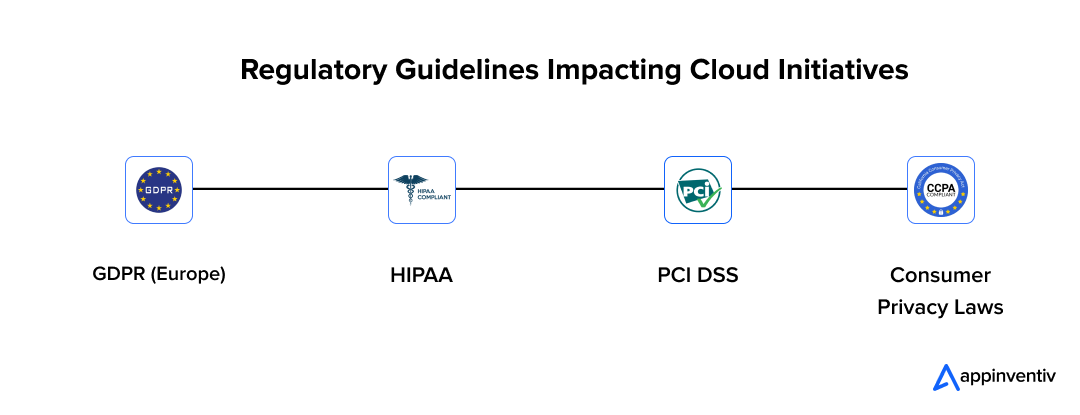
GDPR (Europe): Perhaps the most well-known, the General Data Protection Regulation transformed the way enterprises think about personal data. Cloud storage GDPR compliance is not simply about keeping European data in European servers. It requires demonstrable control over data lifecycles: the ability to locate an individual’s information on demand, amend it when inaccuracies are found, and delete it entirely if requested.
Enterprises that cannot provide this level of transparency risk fines up to €20 million or 4% of global turnover – a figure that has already been enforced against tech giants and mid-sized firms alike. Beyond the fine, GDPR has set the global tone: customers everywhere now expect this level of control, even where it is not legally mandated.
Also Read: How to Develop a GDPR-Compliant Software for Your Business?
HIPAA: For the health sector, secure cloud hosting compliance under HIPAA is non-negotiable. Patient records are among the most sensitive forms of data, and breaches carry both financial penalties and loss of patient trust. HIPAA requires encryption at rest and in transit, strict user authentication, and auditable activity logs.
The penalties range up to $1.5 million per violation category per year, and enforcement is active: the Department of Health and Human Services (HHS) has collected more than $144 million in HIPAA settlements. For executives, HIPAA compliance is not just about avoiding penalties; it is about sustaining credibility in a sector where trust is everything.
Also Read: HIPAA Compliant App Development in 2025: A Complete Guide
PCI DSS: Payment card data is another high-risk category, tightly governed by PCI DSS. Unlike GDPR or HIPAA, PCI DSS is industry-enforced, but its impact on cloud projects is just as profound. Cloud risk management and compliance here means continuous monitoring, intrusion detection, regular vulnerability scanning, and evidence of encryption.
Penalties for non-compliance range from $5,000 to $100,000 per month, but the bigger risk is contractual: card networks can revoke an enterprise’s ability to process payments altogether. For a retailer, that’s not a fine, it’s an existential risk.
Also Read: How to Develop a PCI-Compliant Mobile App?
Consumer Privacy Laws: A newer wave of regulations is expanding the net of legal compliance in cloud computing. California’s CCPA/CPRA grants consumers rights similar to GDPR, while India’s Digital Personal Data Protection (DPDP) Act brings GDPR-like obligations to a vast new market. These laws force global businesses to think beyond a single compliance framework. A cloud strategy that works for Europe may fail in California, and one that passes muster in the U.S. may not meet India’s standards.
For C-suites, the insight is clear: compliance must be built with flexibility in mind, or every expansion will bring new delays and costs.
Regulatory frameworks are not background noise; they shape every major cloud project. Before greenlighting migration, boards should demand a clear mapping of each workload to the regulations it touches. Ask: Which laws apply here, and can we prove alignment today – not after an audit notice arrives?
Certifications and Standards: The Passports to Market Access
If regulations define what enterprises must do, certifications and standards prove that they’ve done it. For global businesses, cloud compliance certifications and alignment with cloud regulatory standards are no longer optional. They are often prerequisites to enter certain industries, win contracts, or even remain in an existing supply chain.
Why do certifications matter? In enterprise sales cycles, procurement teams routinely ask for evidence of compliance. Without SOC 2, many SaaS providers never make it past the first conversation with large buyers. Without ISO 27001, international partners often hesitate to share sensitive data. Without FedRAMP, selling into the U.S. federal government is impossible. Certifications are not paperwork – they are business accelerators.
It’s tempting to treat certifications as the whole story, but they rarely cover the full scope of governance. What boards and regulators often look for are the broader compliance standards in cloud computing – the frameworks that guide how security and compliance are actually run day to day. Think of ISO, NIST, and CIS; they don’t just sit on a certificate; they act as playbooks. In reality, these standards give enterprises a common language across regions, auditors, and even investors who want reassurance that controls are more than ad hoc.
Take ISO, for instance. When leadership sees ISO 27001 as the backbone of their information security management system, it signals process, discipline, and accountability. On the other hand, NIST offers a flexible but rigorous model that helps organizations adapt to new risks without reinventing governance each time. CIS Benchmarks go a level deeper, providing the configuration guardrails that engineers can actually apply in cloud deployments.
The point here is not that standards replace certifications – they don’t. Instead, they provide structure and predictability underneath them. An enterprise that demonstrates alignment with ISO, NIST, and CIS is telling its stakeholders something beyond “we passed an audit.” It’s showing that resilience and governance are embedded into operations, which reduces partner hesitation and gives investors confidence that compliance won’t fall apart under stress.
Comparison of Major Cloud Compliance Certifications
| Certification | Scope | Benefits | Business Impact |
|---|---|---|---|
| ISO 27001 | Information Security Management System (ISMS) across industries | Establishes systematic governance of security risks; recognized worldwide | Essential for global expansion and international partnerships |
| SOC 2 | Trust Services Criteria: security, availability, confidentiality, processing integrity, privacy | Third-party assurance of operational security controls | Speeds up enterprise procurement cycles; often mandatory for B2B SaaS |
| FedRAMP | U.S. federal cloud service authorization | Aligns with stringent U.S. federal security and privacy controls | Grants access to government contracts; boosts credibility in regulated sectors |
Real-world impact: A SaaS company that secures SOC 2 certification often sees sales cycles shorten by months because buyers no longer need extensive custom due diligence. A manufacturer with ISO 27001 finds international expansion smoother because partners already recognize the certification as proof of compliance. And for cloud providers, FedRAMP authorization can unlock billion-dollar federal opportunities that would otherwise remain inaccessible.
Certifications and standards are more than risk management tools. They are passports into markets. Executives should ask: Which certifications unlock customers or contracts for us – and what is the opportunity cost of not pursuing them?
What Does Compliance Really Mean in Practice
It’s easy to talk about GDPR, HIPAA, or PCI DSS at the level of principles. The reality is more demanding. Cloud storage GDPR compliance forces companies to track an individual’s data across fragmented systems, erase it when asked, and report a breach within just 72 hours. That is not theory – it is a countdown clock that starts the moment something goes wrong.
HIPAA takes the same uncompromising stance on patient data. Records must be encrypted in motion and at rest, role-based access is non-negotiable, and every user action has to be logged in case regulators demand proof.
PCI DSS, governing payments, adds its own pressure. Cardholder data must sit behind encryption layers, be monitored continuously, and undergo constant vulnerability testing. These frameworks may look different on paper, but they all drive toward the same reality: compliance is visible, technical, and traceable.
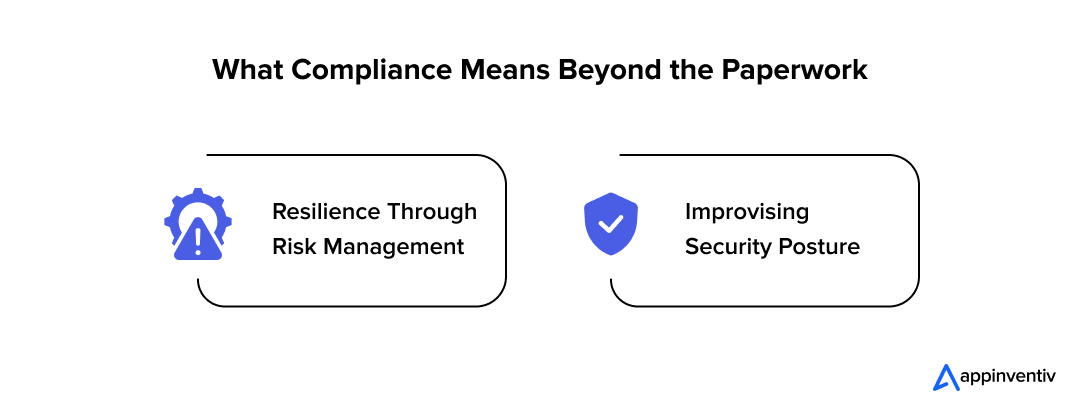
Resilience Through Risk Management
Meeting sector rules is one thing. Surviving unexpected events is another. A single misconfigured cloud bucket has been enough to trigger penalties and headlines for global brands. This is why cloud risk management and compliance cannot be a quarterly checklist. Risk assessments, breach simulations, and vendor monitoring build resilience long before the regulator’s letter arrives. Without them, enterprises are left reacting under pressure, often at far greater cost than prevention would have required.
The Role of Security Standards
Each provider has their own shared-responsibility model, tooling, and gaps, which introduce greater complexities in hybrid or multi-cloud environments. Without a baseline, the picture quickly fragments. This is where cloud security standards such as ISO 27001, the NIST Cybersecurity Framework, and CIS Benchmarks provide discipline. They give leaders a common playbook to enforce across geographies and vendors. More importantly, they give regulators and customers confidence that the enterprise is not improvising its security posture.
Takeaway for businesses.
Cloud data protection is the currency of trust. Regulators view it as proof of compliance. Customers look for it before they buy. Investors treat it as evidence of risk management. Enterprises that can demonstrate control consistently earn the freedom to innovate. Those who cannot carry an invisible question mark into every negotiation, every audit, and every growth initiative.
Turn compliance into a strength – consistent, auditable, and built into your cloud.
How Should Businesses Approach Cloud Compliance Audits
For many senior leaders, an audit is the first moment compliance issues rise visibly to the boardroom, which, when approached strategically, becomes one of the most valuable ways to build confidence – not only with regulators, but also with customers and employees inside the enterprise.
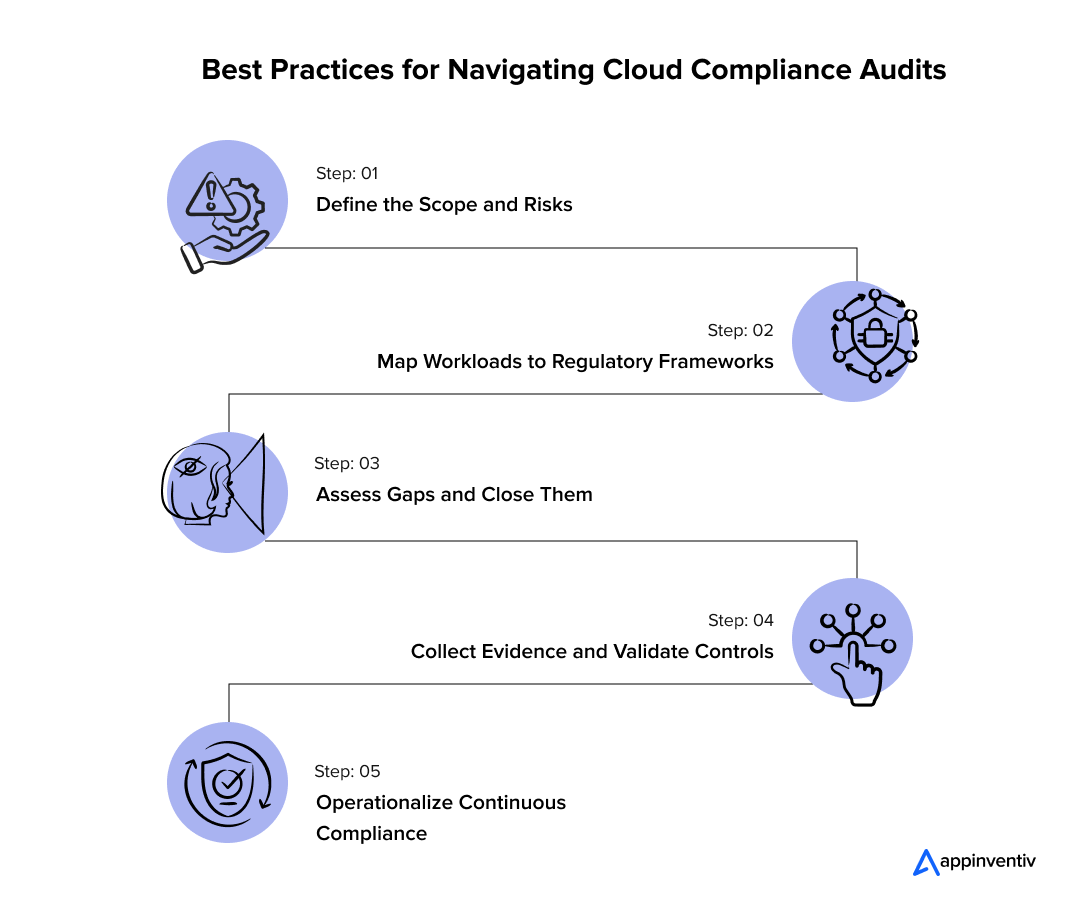
Step 1: Define the Scope and Risks
Every audit begins with clarity. Which workloads will be reviewed? Which regulations are in play – GDPR, HIPAA, PCI DSS, CCPA, or India’s DPDP Act? Scoping is not a technical exercise alone. It defines the organization’s legal exposure, its financial risk, and even the reputational stakes. Miss the scope, and blind spots become costly fines or stalled contracts.
Step 2: Map Workloads to Regulatory Frameworks
Once the scope has been set, workloads should be mapped to obligations. Every dataset, application, and third-party integration must align with specific business requirements, which is where cloud data protection compliance frameworks like ISO 27001, SOC 2, NIST, and CIS come into action. Creating benchmarks here is critical, since they provide leadership with a structured view into which controls are already strong, the ones that are missing, and how much residual risk the enterprise is carrying.
Step 3: Assess Gaps and Close Them
Gap analysis is where strategy turns into execution. Encryption, role-based access, logging, and breach notification protocols are typical fixes, but it is equally critical to embed compliance in cloud storage from the start through encryption at rest and in transit, retention rules, and cross-border transfer safeguards – which avoids costly redesigns later. Closing gaps is not about passing a test; it is about building resilience that holds under pressure.
Step 4: Collect Evidence and Validate Controls
Policies on paper mean little without proof in practice. A credible audit requires logs, access trails, and system configurations that demonstrate compliance working day to day. Independent validation – through penetration testing or third-party assessment – adds weight and makes internal claims defensible before regulators and partners.
Step 5: Operationalize Continuous Compliance
Enterprises that treat audits as once-a-year stress events are always behind. Leaders who embed compliance into everyday operations change the equation. Automation tools that monitor posture, gather evidence, and feed dashboards alongside financial KPIs keep the enterprise audit-ready year-round. This removes the risk of last-minute scrambles and strengthens investor confidence.
Why This Matters at the Leadership Level
- A failed audit can block entry into new markets or delay high-value contracts.
- Successful audits, when grounded in recognized cloud security compliance frameworks, accelerate procurement cycles and send positive signals to regulators and investors.
- Continuous readiness demonstrates discipline. Boards that can show ongoing control are rewarded with trust – both in the market and by regulators.
The Cloud Compliance Maturity Model
Executives need a clear way to benchmark their readiness. A Cloud Compliance Maturity Model provides that lens:
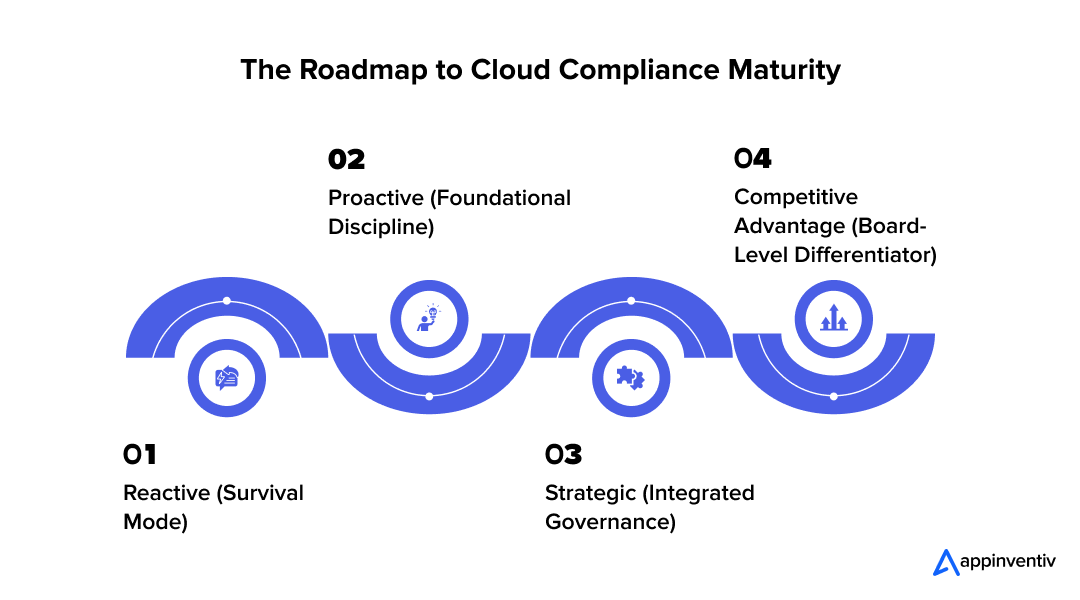
Reactive (Survival Mode): Compliance is ad hoc. Audits feel like crises. Policies exist but are rarely enforced. A single breach exposes major weaknesses.
Proactive (Foundational Discipline): Basic cloud compliance best practices are in place. Teams prepare for audits, apply core compliance standards in cloud computing, and start monitoring risk – but still operate project by project.
Strategic (Integrated Governance): This is where the conversation changes. Compliance isn’t tacked on after design choices; it shapes them. Every major cloud initiative is mapped against cloud security standards – ISO 27001, SOC 2, and NIST. In practice, that means security teams and architects sit at the same table before projects start, not after. A cloud compliance audit also takes on a new role. It isn’t the fire drill it used to be. Boards begin using audit results the way they use financial statements – as a way to spot weaknesses early and strengthen the enterprise before regulators or partners point them out.
Competitive Advantage (Board-Level Differentiator): Very few organizations get here, but when they do, the difference is obvious. Strong cloud security compliance isn’t just a requirement; it becomes part of the brand. Procurement cycles get shorter because customers already see the certifications, negotiations run smoothly because there’s less doubt to resolve, and when the enterprise looks to expand into new regions or prepare for M&A, compliance becomes proof that growth can happen without hidden liabilities. Deals move faster because the evidence is already on the table.
The risks of standing still are not abstract. They show up in numbers: GDPR penalties at 4% of global revenue, HIPAA fines that can reach $1.5 million a year, PCI DSS violations as high as $100,000 per month. For leadership, the key question is no longer “Are we compliant today?” It is “Where exactly are we on this curve – and what’s the cost of waiting another quarter before moving up?”
What Emerging Trends Should Enterprises Prepare For?
Regulation is not standing still. Every year, new cloud compliance and regulations emerge to govern technologies and risks that didn’t exist a decade ago. For the C-suite, this means cloud strategies can no longer be designed around today’s cloud compliance requirements alone – they must anticipate tomorrow’s rules.
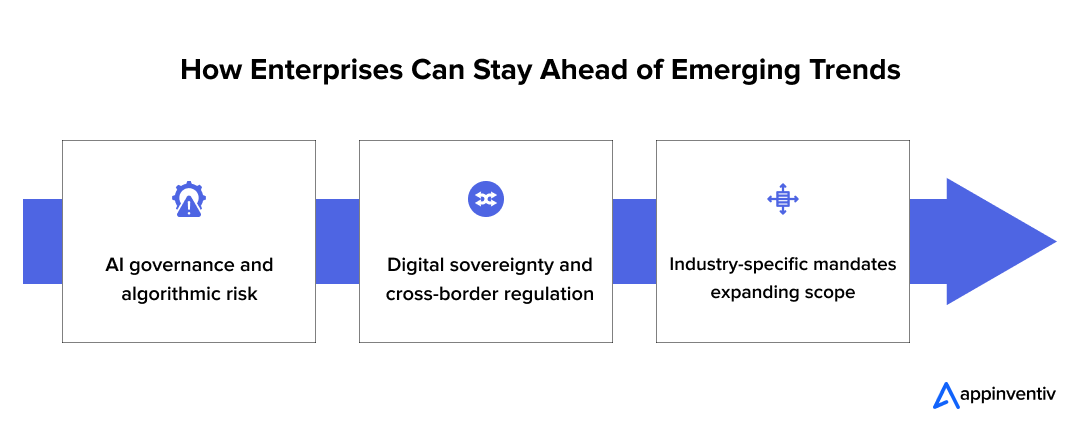
AI governance and algorithmic risk: In Europe, the EU AI Act is moving faster than most regulators, introducing a tiered framework that places the heaviest burden on high-risk AI systems. For enterprises running machine learning in cloud environments, this is not just a compliance box to tick – it means proving transparency, explainability, and ongoing monitoring.
The United States is taking a different route: the NIST AI Risk Management Framework, together with new executive orders, is shaping what “responsible AI adoption” should look like in practice.
Meanwhile, Asia is carving its own path, with China’s AI regulations focusing squarely on algorithmic transparency and mandatory security checks, efforts that are reshaping compliance obligations for global businesses that want to operate at scale. The signal for executives is unignorable – AI and cloud compliance are no longer separate domains, and so governance must also extend beyond data to cover algorithms themselves.
Digital sovereignty and cross-border regulation: Governments are tightening rules on where data can live and how it can move between devices and users. The invalidation of Privacy Shield between the U.S. and EU, followed by the Trans-Atlantic Data Privacy Framework, underscores how volatile these agreements can be. Similar restrictions are emerging across Asia and the Middle East. For enterprises, global expansion is now inseparable from cloud regulatory requirements on digital sovereignty.
Industry-specific mandates expanding scope: Regulation is also deepening within industries. Financial services firms are facing new digital identity requirements designed to combat fraud and money laundering. Manufacturers are being asked to report on sustainability and carbon emissions – obligations that will soon demand cloud-based reporting and validation. These intersect directly with legal compliance in cloud computing, expanding what “compliance” means far beyond security and privacy.
Enterprises that treat compliance as a static project will always struggle to keep up, while those who anticipate regulatory shifts and design adaptable architectures will be able to innovate faster and scale with fewer roadblocks. The winners will be the enterprises that build compliance agility into their cloud strategy.
You don’t need to guess where regulations are heading. We’ll map upcoming compliance risks to your cloud strategy and show you how to stay audit-ready as AI, sovereignty, and industry mandates evolve.
Partnering with Appinventiv for Compliance at Enterprise Scale
Even the strongest internal teams find it difficult to keep pace with the speed of regulatory change. For large enterprises, cloud compliance for enterprises requires more than good IT or legal support. It calls for dedicated expertise, proven frameworks, and tools that go well beyond what most in-house teams can sustain.
Why does internal capacity fall short? Compliance today isn’t a once-a-year activity. It involves continuous monitoring, frequent cloud compliance audits, regular control testing, and oversight of vendors across multiple jurisdictions. Moreover, cloud compliance requirements often shift mid-project, making it critical for enterprises to adapt systems and processes on the fly. Without external expertise, compliance quickly turns into a reactive and expensive fire drill.
This is where Appinventiv comes in – We work with global enterprises to make compliance a growth driver, not a bottleneck. Our teams bring hands-on experience in secure cloud hosting compliance, enabling organizations to build multi-cloud and hybrid systems that satisfy GDPR, HIPAA, PCI DSS, and new mandates simultaneously. The difference lies in the approach: we don’t just interpret regulations, we design compliance into architecture, data flows, and operating playbooks from the very start.
The strategic advantages of our cloud services for the C-suite.
- Staying ahead of change. Our focus on ongoing alignment with evolving cloud compliance and regulations ensures enterprises are able to anticipate requirements instead of reacting under pressure later.
- Accelerated certifications. We build processes that enable faster access to cloud compliance certifications such as ISO 27001, SOC 2, and FedRAMP, which allows enterprises to enter markets more quickly.
- Audit-ready operations. The automated evidence collection and reporting functionality we build on cloud data protection compliance frameworks (ISO, NIST, CIS) makes audit cycles shorter and less disruptive.
- Global scalability. Cloud environments are designed so that operations in any geography remain compliant with local cloud regulatory requirements, without slowing innovation.
For executives, partnering with Appinventiv does not mean handing over accountability – the board still owns the mandate. What it does mean is that enterprises gain access to the expertise, processes, and monitoring capabilities needed to cut risk, accelerate digital projects, and reassure regulators, customers, and investors that compliance is under control.
The Boardroom Checklist for Cloud Compliance Readiness
When enterprises expand or migrate workloads into the cloud, compliance can’t be left in the background. It is not just an IT or legal function anymore; board members also need a transparent view into whether the organization is genuinely prepared for scrutiny. A concise checklist here would allow leaders to filter out technical noise and focus directly on three things: risk, readiness, and growth.
Five Critical Questions Every Board Should Ask
- Beyond our internal controls, which cloud regulatory requirements apply to the workloads we are running in each market, and are we confident that nothing has been overlooked?
- If tomorrow a regulator demanded evidence, could we demonstrate – without delay – that we are audit-ready through a formal cloud compliance audit?
- From a market-access perspective, which of the cloud compliance certifications (ISO 27001, SOC 2, FedRAMP) are essential for our current contracts and for the geographies we want to expand into?
- Looking at our ecosystem of providers, do our vendors and partners align with recognized cloud security compliance frameworks like ISO, NIST, or CIS, or can they expose us to any additional risk?
- How directly does our compliance posture affect valuation – whether through revenue opportunities, M&A readiness, or the level of confidence our investors place in us?
Quick Self-Test for Audit Preparedness
- Evidence (policies, logs, configurations) can be produced within 48 hours.
- Every critical workload is mapped to its regulatory framework (GDPR, HIPAA, PCI DSS, CCPA/DPDP).
- Remediation timelines from past audits are tracked and closed.
- Certifications are current and aligned with target markets.
- Any unchecked box signals readiness gaps.
Ongoing Oversight for the Board
- Standing Agenda Item. Review cloud security compliance frameworks at every board risk meeting.
- Key Metrics to Monitor.
- % of workloads mapped to frameworks
- Number of unresolved critical audit findings
- Time to produce audit evidence
- Certification coverage vs. strategic markets.
Conclusion
Treating compliance as a priority item enables enterprises to move faster with confidence. With the right frameworks and controls in place, organizations scale to new markets, satisfy regulators, and strengthen trust with customers and investors alike.
The enterprises that succeed are not necessarily the ones with the most advanced platforms, but those where boards have made regulatory compliance in cloud computing a central pillar of transformation. By doing so, they reduce fines, prevent costly disruptions, and gain access to markets where trust is the deciding factor in whether deals move forward.
The evidence throughout this playbook points to a consistent pattern. Regulations such as GDPR, HIPAA, and PCI DSS do more than set boundaries – they shape the architecture of every cloud project. Cloud compliance certifications and alignment with cloud data protection security compliance frameworks are what demonstrate market readiness, often serving as gatekeepers to contracts and partnerships. Embedding compliance in cloud storage, adopting recognized cloud security standards, and running disciplined cloud compliance audits turn regulatory obligations into operational strengths. And looking ahead, enterprises that anticipate new cloud compliance and regulations – from AI governance to digital sovereignty and industry-specific mandates – will find themselves able to innovate without pause.
For the C-suite, the mandate is clear. Compliance is no longer a checklist delegated to IT but a strategic discipline that underpins resilience, shapes credibility in the market, and drives long-term enterprise value.
FAQs
Q. What does cloud compliance mean?
A. Say “cloud compliance,” and most folks picture a wall of regulations. GDPR, HIPAA, PCI DSS – the usual suspects. That’s true, but the idea goes further. At its core, compliance just means your cloud setup plays by the same rules as if the servers were sitting in your office. Privacy, security, accountability – the whole lot. The trickier part isn’t the tech. It’s being able to show, with proof, that your safeguards work when a regulator or even a customer starts asking questions.
Q. What are the biggest compliance risks when moving to the cloud?
A. Misconfigurations are the classic slip-up. One forgotten setting on a storage bucket, and suddenly, millions of records are exposed. Then there’s vendor risk – if your cloud provider cuts corners, the liability doesn’t shift; it’s still on you. But the real headache is visibility. Once workloads are scattered across services, many organizations honestly can’t say where their most sensitive data lives. And if you can’t point to it, you can’t protect it.
Q. What are the GDPR requirements for cloud data storage?
A. With GDPR, storage isn’t just about where you park the data. You need to know exactly where personal information sits, be ready to fix or erase it if someone makes a request, and sound the alarm within 72 hours if a breach happens. Moving data outside the EU? Still possible – but only if you use legally approved safeguards. The real point here is control. Regulators don’t want promises; they want to see that you stay in control of personal data day in and day out.
Q. What does HIPAA compliance mean for cloud computing?
A. HIPAA rules don’t disappear in the cloud. Health records still need to be encrypted at rest and while moving, access has to be limited to the right roles, and every action must be logged. The part many forget is the paperwork: even if you’ve ticked all the technical boxes, you’re not HIPAA compliant without a Business Associate Agreement (BAA) signed with your provider. No BAA, no compliance – it’s that simple.
Q. What is PCI DSS compliance in cloud computing?
A. PCI DSS covers how cardholder data is handled, and the cloud doesn’t change that. You still need encryption, vulnerability scans, strong access rules, and constant monitoring. The wrinkle is that it’s a shared responsibility. Your provider covers some controls; you handle others. If either side misses a step, compliance breaks.
Q. What are the common compliance challenges in the cloud?
A. Data residency is always a sticking point, especially when data crosses borders. But the bigger mess shows up in multi-cloud setups. Each provider has its own “shared responsibility” model, and if you don’t align them under one governance framework, you’ll end up with blind spots. Those gaps are exactly where compliance slips through.
Q. What do organizations need to do to comply with GDPR in cloud environments?
A. At a minimum, map out where personal data travels, encrypt it, and keep records of how it’s processed. That’s the technical side. On the legal side, contracts with your cloud provider need to spell out GDPR responsibilities clearly. If those duties aren’t written down, accountability gets muddy, and regulators won’t accept “we weren’t sure whose job it was” as an excuse.
Q. What technical and organizational measures are required for GDPR cloud compliance?
A. Technical steps include encryption, tight access restrictions, retention limits, and procedures for breach notifications. But GDPR isn’t just about tech. Staff need training, audits need to happen regularly, and vendors need oversight. Regulators want to see that compliance is part of the culture – not just a checklist IT ticks once a year.
Q. Is a public cloud HIPAA compliant?
A. It can be, but don’t assume it is by default. Public cloud providers often offer the right features — encryption, access controls, logging — but you have to configure them correctly. And again, without a signed BAA, none of it counts. The paperwork is as important as the technology.
Q. What constitutes a HIPAA-compliant cloud drive?
A. Think of it as three pieces: encryption (both at rest and in transit), role-based access, and detailed audit logs. Get those in place, and you have the technical foundation. But the BAA is what seals the deal. Without it, the drive might be secure, but it won’t be compliant.
Q. Can you store payment data in the cloud and remain PCI compliant?
A. Yes – plenty of businesses do it every day. But PCI compliance in the cloud is fragile, as you require several layers of protection: encryption everywhere, real-time monitoring, and a clear agreement with your provider on who manages which controls. Miss even one of those elements, and the whole compliance effort can fall apart.





















